The Seagate Exos X24 24TB HDD is a high-capacity drive designed to meet the storage needs of enterprise-level data centers and hyperscale environments. Starting at 12TB, the 24TB model we’re focusing on offers a significant amount of storage space for data-intensive applications. The Exos X24 also leverages Conventional Magnetic Recording (CMR) technology to maximize storage density and reliability, ensuring it can handle the rigorous demands of continuous, data-intensive operations.
Focusing on performance, the Exos X24 utilizes helium technology within its 3.5-inch form factor and operates at a spindle speed of 7200 RPM. It supports SATA and SAS interfaces, ensuring compatibility with a wide array of enterprise storage systems. The quoted sustained data rate of up to 285MB/s is on par among HDDs of its class, while Seagate indicates it can handle continuous data transfers effectively.
Mean time between failures (MTBF) for the Exos X24 is 2.5 million hours, which is typical for high reliability and durability in 24/7 operational conditions. These metrics imply that the Exos X24 is built to support demanding workloads, including those found in data analytics, cloud storage, and digital archiving, where speed and reliability are paramount.
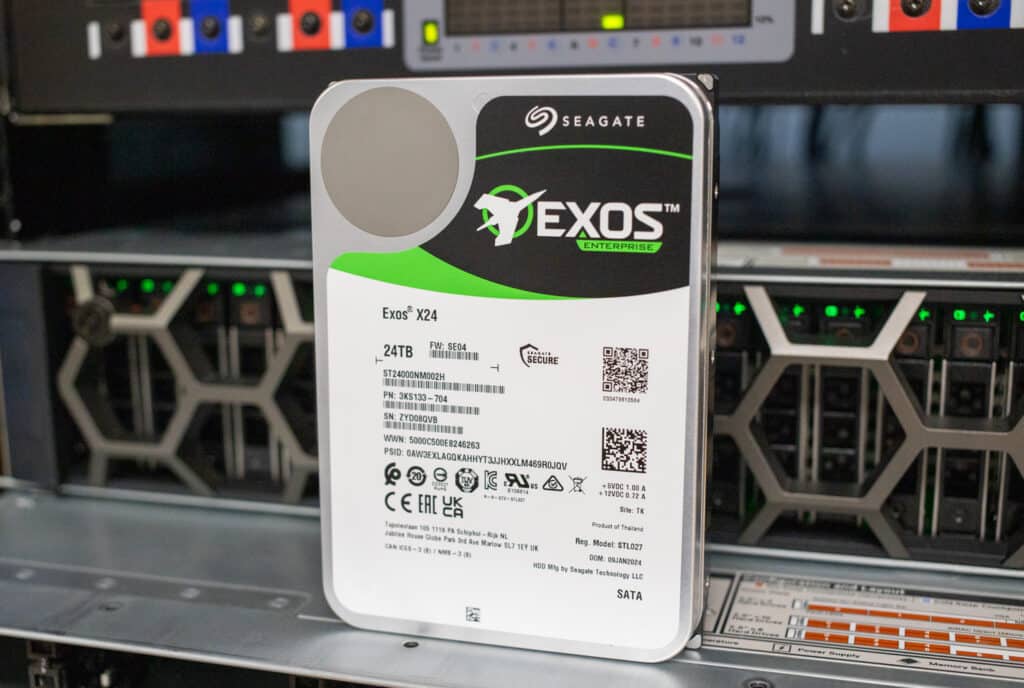
Seagate Exos X24 24TB Features
The Exos X24 feature set includes several key technologies aimed at enhancing data security and operational efficiency. Self-encrypting drive (SED) technology, for example, provides automatic data encryption, offering an essential layer of security for sensitive information. The instant secure erase (ISE) feature allows for quick and safe disposal of data when drives are repurposed or disposed of.
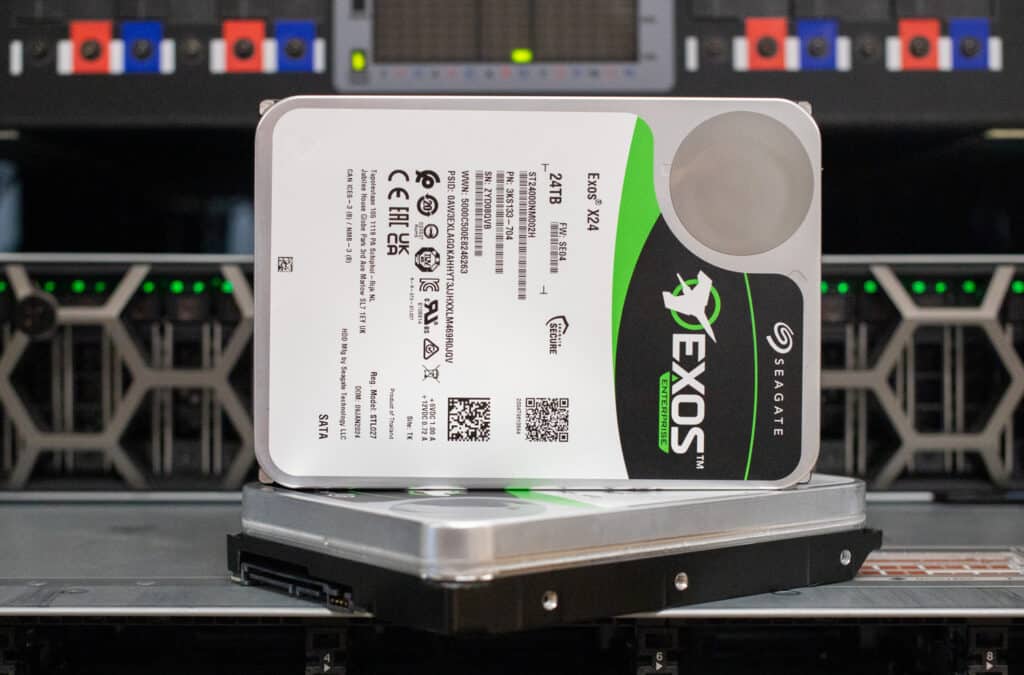
For data centers focused on optimizing power efficiency, the Exos X24 includes PowerChoice and PowerBalance technologies. PowerChoice is designed to help enterprises manage power consumption in their data storage systems by offering customizable settings for idle power savings without sacrificing performance.
PowerBalance, on the other hand, optimizes the balance between power consumption and performance across various operational states, ensuring more efficient energy use while maintaining high data throughput. These features contribute to lower operating costs and sustainability targets by reducing energy consumption.
Seagate Exos X24 24TB HDD Specifications
| Specifications | SATA 6Gb/s |
| Capacity | 24TB |
| Standard Model – Seagate Instant Secure Erase (ISE) | ST24000NM002H |
| SED Model | ST24000NM001H |
| SED-FIPS | — |
| Features | |
| Helium Sealed-Drive Design | Yes |
| Conventional Magnetic Recording (CMR) | Yes |
| Protection Information (T10 DIF) | — |
| Super Parity | Yes |
| Low Halogen | Yes |
| PowerChoice Idle Power Technology | Yes |
| PowerBalance Power/Performance Technology | Yes |
| Hot-Plug Support | Yes |
| Cache, Multisegmented (MB) | 512 |
| Organic Solderability Preservative | Yes |
| RSA 3072 Firmware Verification (SD&D) | Yes |
| Reliability/Data Integrity | |
| Mean Time Between Failures (MTBF, hours) | 2500000hr |
| Reliability Rating @ Full 24×7 Operation (AFR) | 0.35% |
| Nonrecoverable Read Errors per Bits Read | <1 in 10E15 |
| Power-On Hours per Year (24×7) | 8760 |
| 512e Sector Size (Bytes per Sector) | 512 |
| 4Kn Sector Size (Bytes per Sector) | 4096 |
| Limited Warranty (years) | 5 |
| Performance | |
| Spindle Speed (RPM) | 7200RPM |
| Interface Access Speed (Gb/s) | 6.0, 3.0 |
| Max. Sustained Transfer Rate OD (MB/s,MiB/s) | 285/272 |
| Random Read/Write 4K QD16 WCD (IOPS) | 168/550 |
| Average Latency (ms) | 4.16ms |
| Interface Ports | Single |
| Rotation Vibration @ 20-1500 Hz (rad/sec) | 12.5 |
| Power | |
| Idle A (W) Average | 6.3 |
| Max Operating, Random Read/Write 4K/16Q (W) | 8.9, 7.1 |
| Power Supply Requirements | +12V and +5V |
| Environmental | |
| Temperature, Operating (°C) | 10°C – 60°C |
| Vibration, Nonoperating: 2 to 500Hz (Grms) | 2.27 |
| Shock, Operating 2ms (Read/Write) (Gs) | 40Gs |
| Shock, Nonoperating 2ms (Gs) | 200 |
| Physical | |
| Height (mm/in, max) | 26.1mm/1.028in |
| Width (mm/in, max) | 101.85mm/4.010in |
| Depth (mm/in, max) | 147mm/5.787in |
| Weight (gm/lb) | 685g/1.51lb |
Seagate Exos X24 24TB HDD Performance
Enterprise Synthetic Workload Analysis
Our enterprise hard drive benchmark process preconditions each drive set into a steady state with the same workload that the device will be tested with, using a heavy load of 16 threads and an outstanding queue of 16 per thread. The device is then tested in set intervals of multiple thread/queue depth profiles to show performance under light and heavy usage. Since hard drives reach their rated performance level quickly, only the main sections of each test are graphed.
Preconditioning and Primary Steady-State Tests:
- Throughput (Read+Write IOPS Aggregate)
- Average Latency (Read+Write Latency Averaged Together)
- Max Latency (Peak Read or Write Latency)
- Latency Standard Deviation (Read+Write Standard Deviation Averaged Together)
Our Enterprise Synthetic Workload Analysis includes four profiles based on real-world tasks. These profiles have been developed to make it easier to compare to our past benchmarks, as well as widely-published values such as max 4K read and write speed and 8K 70/30, which is commonly used for enterprise drives.
4K
- 100 percent Read or 100 percent Write
- 100 percent 4K
8K 70/30
- 70 percent Read, 30 percent Write
- 100 percent 8K
8K (Sequential)
- 100 percent Read or 100 percent Write
- 100 percent 8K
128K (Sequential)
- 100 percent Read or 100 percent Write
- 100 percent 128K
4K 100 Percent Read/Write
Our first test measures 4K random performance. In this test, the Seagate Exos 24TB achieved 6,000 IOPS read and 1,763 IOPS write in SMB, while the WD Gold hit 4,187 IOPS read and 1,417 IOPS write. In iSCSI, the Seagate drives reached 6,200 IOPS read and 1,825 IOPS write, whereas the WD Gold drives showed 4,373 IOPS read and 1,398 IOPS write.
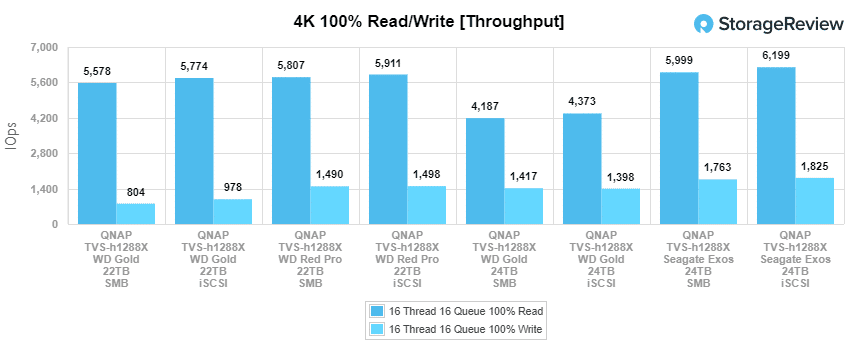
For average latency, the Seagate Exos exhibited 42.67ms read and 145.14ms write in SMB, while recording 41.289ms and 140.21ms in iSCSI, respectively. The WD Gold displayed 61.13ms read/180.51ms write, and 58.52ms read/182.92ms write in SMB and iSCSI, respectively.
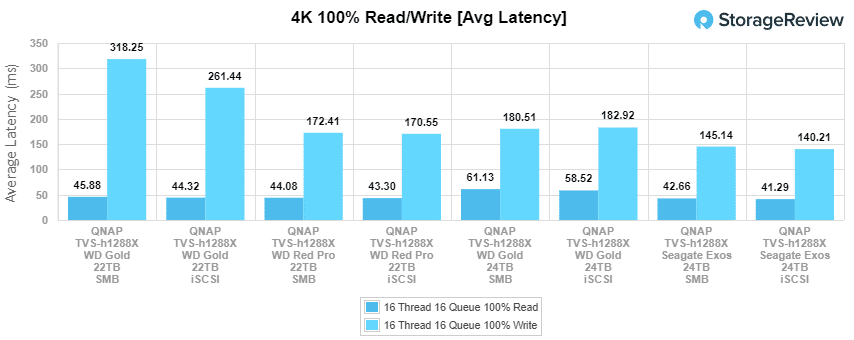
At maximum latency, we observed a significant difference between the WD and Seagate 24TB drives in terms of write activity. In SMB, the Exos drive showed a maximum of 1,119.1ms read and 2,315.1ms write, while iSCSI peaked at 680.6ms and 695ms, respectively. On the other hand, the Seagate drives recorded 759.98ms read and 4,322.5ms write in SMB, and 1,228.1ms read and a substantial 31,059ms write in iSCSI.
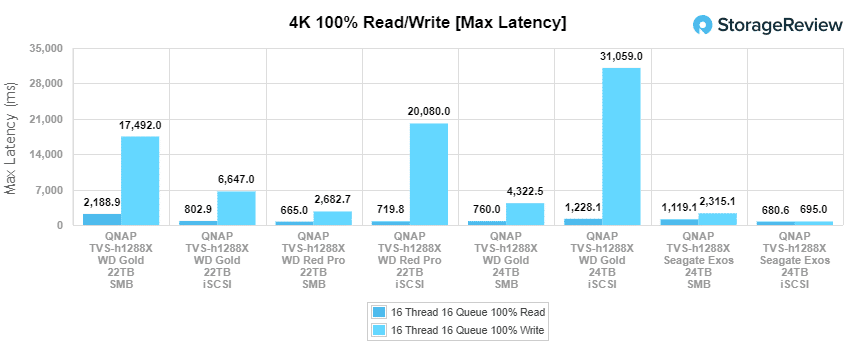
In terms of standard deviation, the Seagate Exos drives recorded 40ms for read and 237.9ms for write in the SMB configuration, while iSCSI showed 42.57ms for read and 74.84ms for write. As for the WD Golds, SMB had 37.06ms for read and 373.254ms for write, while iSCSI recorded 104.53ms for read and 1,178ms for write.
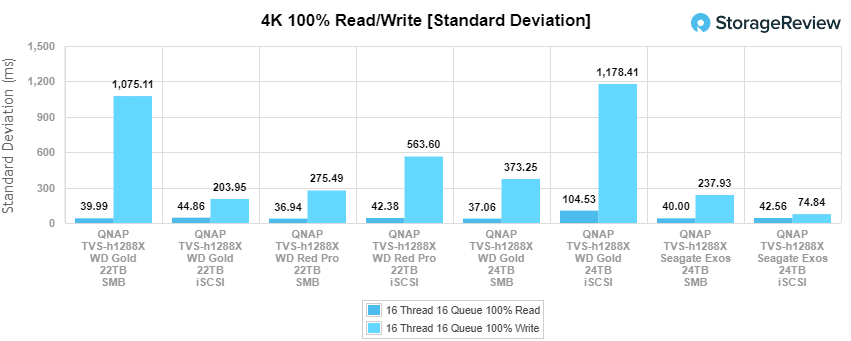
8K 100 Percent Read/Write
In the 8K Read/Write test, both drives showed significant performance improvements compared to the 4K Read/Write test. In the iSCSI setup, the Seagate drives achieved 251K IOPS read and 253K IOPS write, while in SMB, they reached 140K IOPS read and 76K IOPS write. As for the WD Golds, they achieved 157K IOPS read and 95K IOPS write in SMB, and 215K IOPS read and 228K IOPS write in iSCSI.
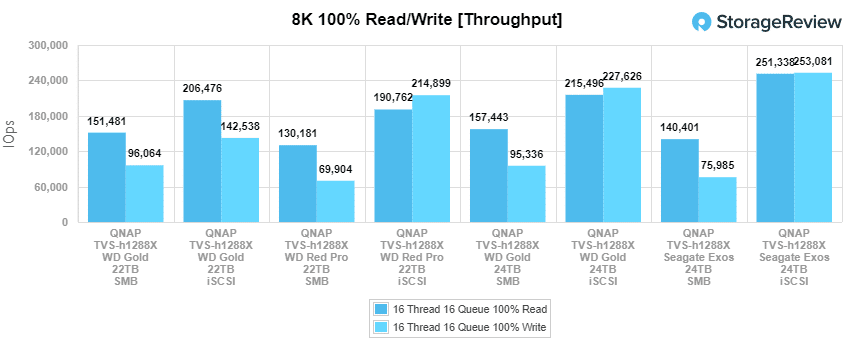
8K 70 Percent Read 30 Percent Write
The other type of workload we run shifts from a pure sequential read/write scenario to a mixed workload, which demonstrates how performance scales from 2T/2Q to 16T/16Q. Here, the performance is fairly consistent via SMB, with a minimum of 589 IOPS and a maximum of 1892 IOPS. With iSCSI, we see a minimum of 495 IOPS and a maximum of 2,186IOPS, with generally consistent performance all around.
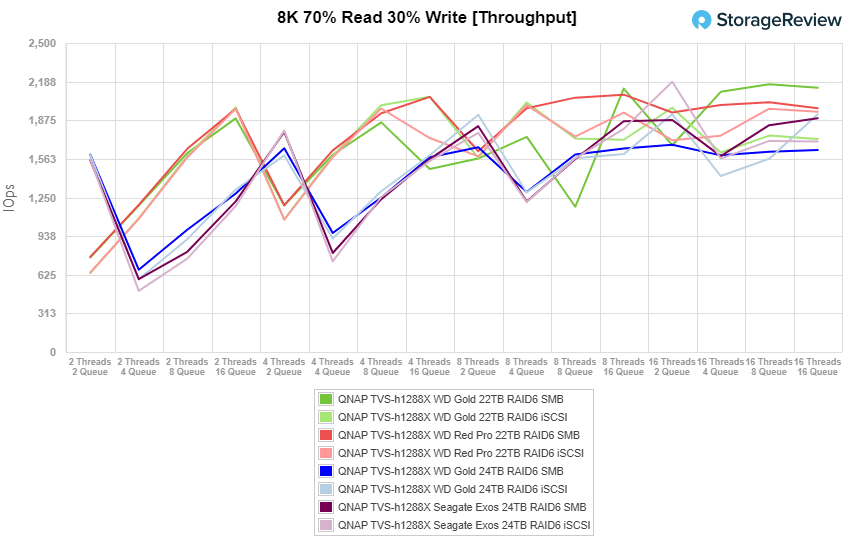
For average latency, we see some noticeable spikes (in SMB) as high as 135,7ms while going as low as 6.77ms at T4/Q2. With iSCSI, we had as low as 8.05ms and maxed out at 75ms on 16T/16Q.
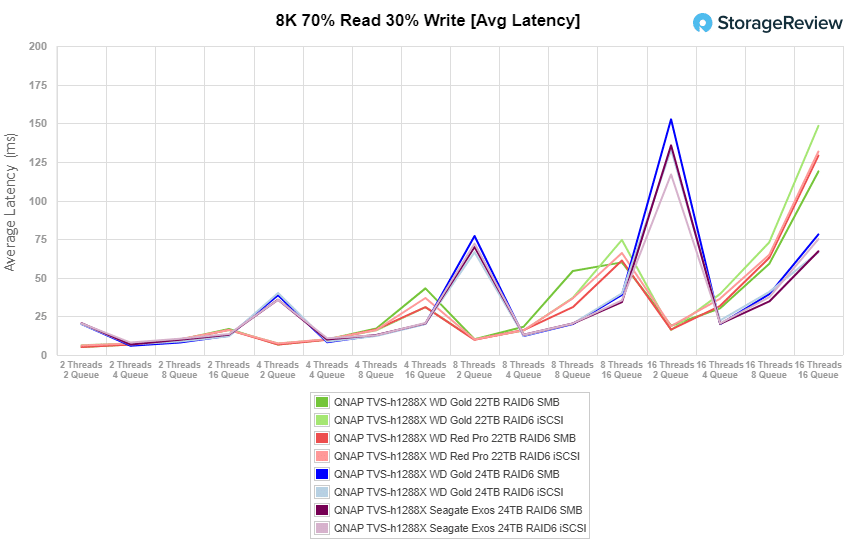
In the 8K 70/30 test, we observed that the Seagate Exos drives exhibited significantly higher latency with SMB compared to iSCSI. Specifically, the latency with SMB started at 3,026ms and peaked at 4,839ms, whereas iSCSI showed lower and more consistent latency, starting at 1,168ms and peaking at only 1,800ms.
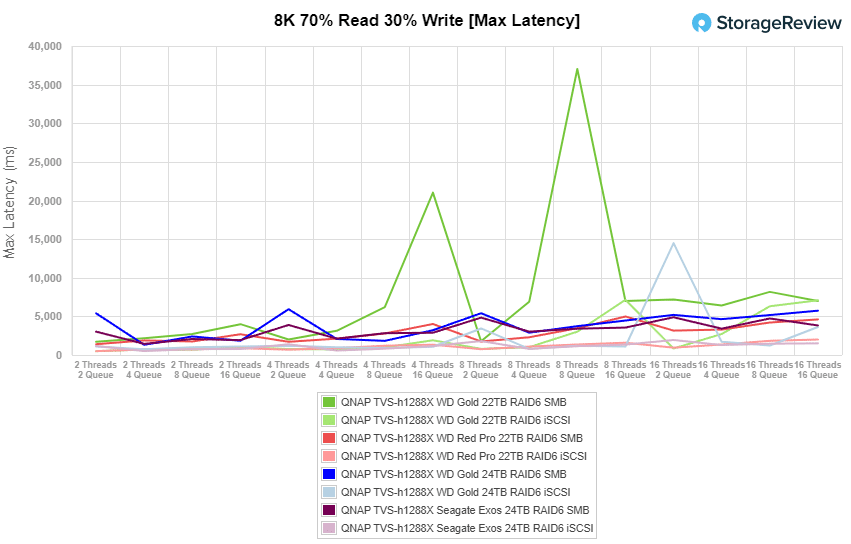
In the final part of the 8k 70/30 test, we observed that the iSCSI configuration performed better in terms of standard deviation. Specifically, the iSCSI setup showed a range of 69.5ms to 118.18ms, while the SMB setup exhibited a range of 95ms to 187.12ms. It’s worth noting that the SMB setup experienced a lower latency of 22.1ms at Q4/T2.
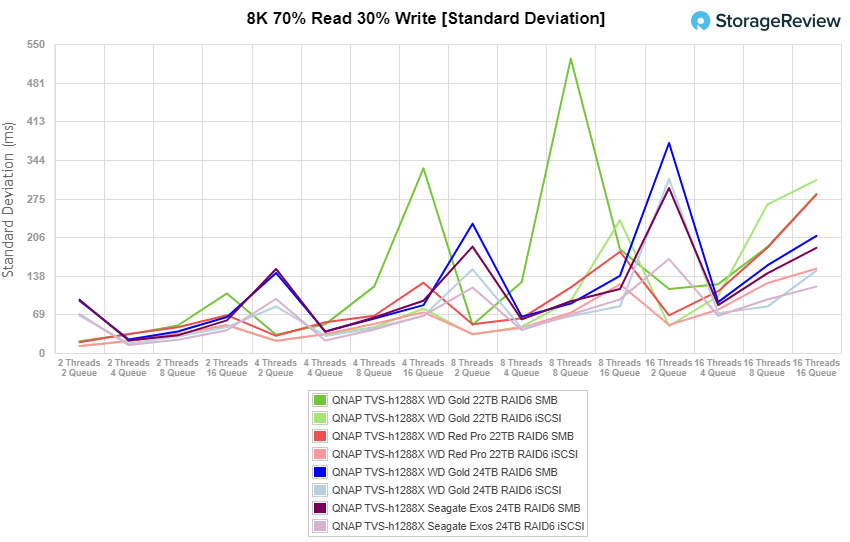
128K 100 Percent Read/Write
Our final test is the 128K 100% Read/Write test. This test involves large blocks and demonstrates the highest sequential transfer speed that the drives can achieve. For SMB performance, the Seagate Exos recorded 2.31GB/s read and 2.29GB/s write, while SMB achieved 2.31GB/s read and 2.3GB/s write. In comparison, the 24TB WD Gold only managed 1.38GB/s read and 2.3GB/s write for SMB, and 2.08GB/s read and 2.27GB/s write for iSCSI.
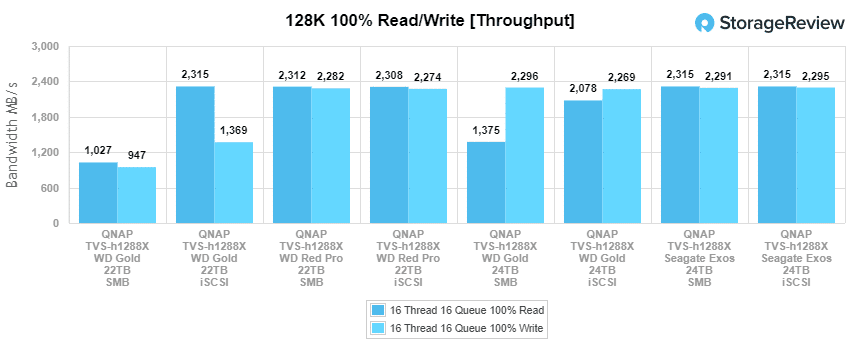
Conclusion
The Seagate Exos X24 24TB HDD emerges as a great solution for enterprises grappling with the challenges of data explosion and the need for reliable, high-capacity storage. This drive is a massive capacity point in Seagate’s Exos lineup and offers a blend of advanced features designed to meet the rigorous demands of modern data centers.
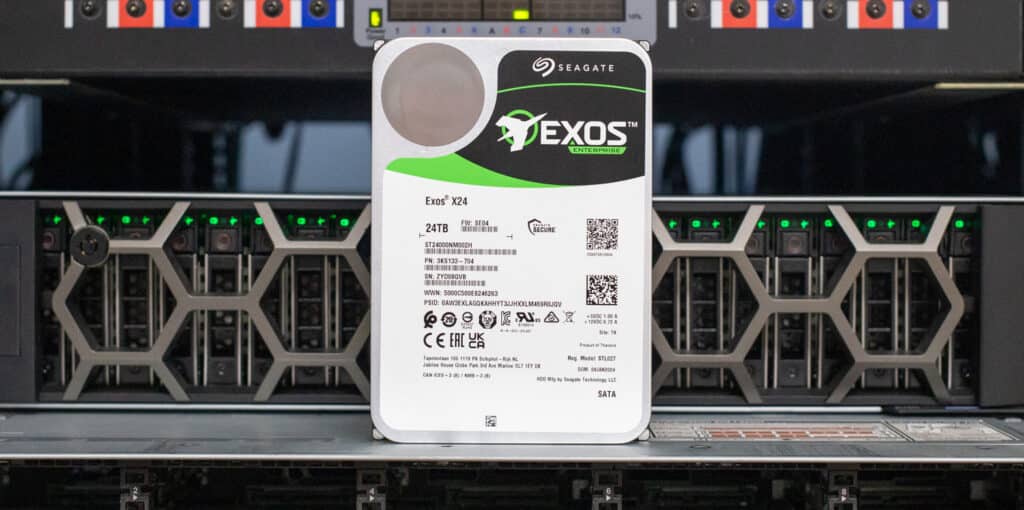
We compared Exos’s performance mainly against a range of high-capacity HDDs, particularly the 24TB WD Gold. Overall, it revealed Exos’s superior performance across most of our benchmarks.
Overall, the Seagate Exos X24 is certainly a strategic investment for data-driven organizations seeking to future-proof their data management strategies due to its impressive combination of high capacity, performance, and operational sustainability.




 Amazon
Amazon